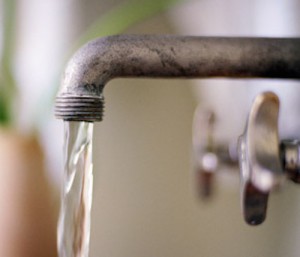Kendall Co. Health Dept. issues caution on lead poisoning
Chronicle Media — March 14, 2016
Lead can enter drinking water through corrosion of plumbing materials. (Photo courtesy Leadsafeillinois.org)
The Kendall County Health Department wants our community to know that lead poisoning is a significant health concern, especially for children. Although leaded paint and gasoline are no longer manufactured in the United States, children and adults can still be exposed to lead through diverse means and sources.
However, lead poisoning is preventable.
Lead paint dust is the most common way in which people are exposed, according to the Heatlh Department. Lead paint is common inside and outside homes built before 1978. Ordinary household repair and maintenance activities stir up dust. It’s important to use lead-safe work practices or use a licensed lead-safe contractor for remodeling or repairs if the home was built before 1978.
For information on lead-safe remodeling and licensed lead-safe contractors, visit Illinois Department of Public Health athttp://www.cdc.gov/nceh/lead/programs/il.htm.
Although rare, lead may also be found in some imported candies, toys, toy jewelry and some cosmetics. The potential for children to be exposed to lead from candy imported from Mexico has prompted the U.S. Food and Drug Administration (FDA) to issue warnings on the availability of lead-contaminated candy and to develop tighter guidelines for manufacturers, importers, and distributors of imported candy.
More information on lead as it pertains to imported candies can be found at http://www.cdc.gov/nceh/lead/tips/candy.htm ; information on toy recalls can be found at http://www.cpsc.gov/en/Taxonomy/Hazards/Chemical/Lead/; information on toy jewelry can be found at http://www.cdc.gov/nceh/lead/tips/jewelry.htm ; and information on cosmetics can be found athttp://www.fda.gov/Cosmetics/ProductsIngredients/PotentialContaminants/ucm388820.htm
Food and drink should not be stored or served in leaded crystal or lead-glazed pottery, because lead can leach from these containers into the food or drink.
Crafters working with lead, and individuals whose occupation involves working with or around sources of lead, especially in the form of lead-laden dust, will want to take safety precautions to avoid any potential for harmful personal exposure, as well as the potential for unintended exposure of their children and loved ones.
Measures such as hand washing, showering, removing work shoes at the door and laundering exposed clothing can serve to minimize exposure to others.
Lead can also enter drinking water through corrosion of plumbing materials, especially where the water has high acidity or low mineral content that corrodes pipes and fixtures. Corrosion is a dissolving or wearing away of metal caused by a chemical reaction between water and your plumbing.
A number of factors are involved in the extent to which lead enters the water including the chemistry of the water (acidity and alkalinity), the amount of lead it comes into contact with, how long the water stays in the plumbing materials, and the presence of protective scales or coatings inside the plumbing materials.
Homes built before 1986 are more likely to have lead pipes, fixtures and solder. However, even new homes have some risk: even legally “lead-free” plumbing may contain up to 8 percent lead. Beginning January 2014, changes to the Safe Drinking Water Act further reduced the maximum allowable lead content of pipes, pipe fittings, plumbing fittings, and fixtures to 0.25 percent.
The most common problem is with brass or chrome-plated brass faucets and fixtures with lead solder, from which significant amounts of lead can enter into the water, especially hot water. If possible, avoid drawing drinking or cooking water from these taps.
Private water well owners and customers of a public water supply can purchase low cost lead testing kits in home improvement stores to collect samples to then send to a laboratory for analysis. You may also contact a private water lab to inquire on the cost of sampling and testing. A list of Environmental Protection Agency (EPA) certified laboratory for analysis.
A list of EPA accredited local labs can be found at http://www.epa.illinois.gov/topics/drinking-water/private-well-users/accredited-labs/index (Please view the “Laboratories Accredited for Chemical Analyses” section for lead specific testing). Customers of a public water supply can click on the following links to review local water quality reports Yorkville, Oswego, Plano and Newark . Additional information concerning lead in water may be obtained at http://www.cdc.gov/nceh/lead/tips/water.htm
Although there are many sources of potential lead exposure to be aware of; such awareness can help reduce, and even prevent possible exposures to lead. For more information on lead, please visit http://www.cdc.gov/nceh/lead/default.htm, you are also welcome to call the Kendall County Health Department at (630) 553-9100, or visit us at www.kendallhealth.org.
— Kendall Co. Health Dept. issues caution on lead poisoning —







